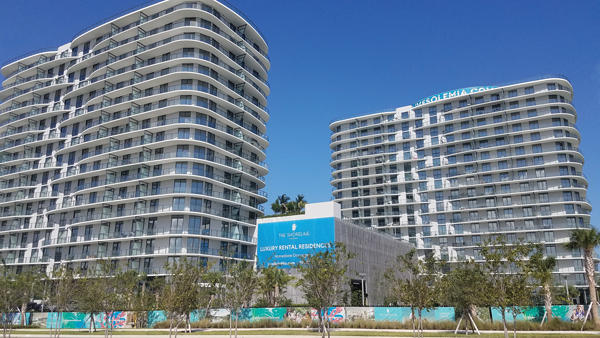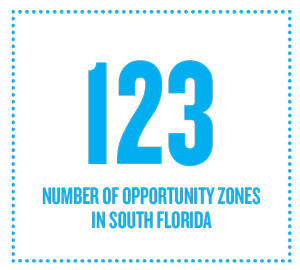
President Trump’s signature accomplishment, his 2017 tax bill, contained a special sweetener for his peers in the real estate development community: the Opportunity Zone program. Investors and developers financing real estate deals could get major tax breaks on their capital gains for up to a decade if they funneled those earnings to projects and businesses in roughly 8,700 low income communities throughout the country in designated “opportunity zones.” According to the Trump administration, the incentives would deliver $100 billion in investment to neglected, struggling neighborhoods across America, including South Florida, where there are 123 Opportunity Zones across Miami-Dade, Broward and Palm Beach counties. The key piece of the program is that, in addition to deferring taxes on their 2018 and 2019 capital gains, investors won’t have to pay any taxes on their profits if they wait 10 years to sell their interests in an Opportunity Zone project.
Proponents hailed the program as a way to entice investors to fund developments in severely depressed communities that otherwise would not attract equity financing. But the zones were determined by U.S. Census data from nearly a decade ago. And two years after the tax bill passed, qualifying projects that plan to reap the program’s benefits are located in areas where gentrification has already been taking place and developers were moving forward with construction long before the program was conceived. For instance, Miami-Dade Opportunity Zones include parts of Miami’s Arts and Entertainment District, Edgewater and the Design District, three neighborhoods that have experienced significant redevelopment since the 2008 crash.
“These are all gentrified areas that are very popular and are being developed,” noted Ronald Fieldstone, a Miami attorney with Saul Ewing Arnstein & Lehr, who is representing about half-a-dozen projects in Opportunity Zones. “But there is nothing wrong with what developers are doing. A lot of these projects would not have happened as quickly. Being an Opportunity Zone is accelerating the process.”
The Real Deal identified five major projects in Miami-Dade, Palm Beach and Broward Opportunity Zones that will reap significant benefits from the program:

SoLe Mia
1. SoLe Mia, North Miami
In March 2015, four months before Trump jumped into the 2016 presidential race, New York real estate titan Richard LeFrak announced that he was teaming up with Turnberry Associates, the Aventura development firm founded by the Soffer family, to build a $4 billion mixed-use project on 184 acres along the waterfront in North Miami. Located on the site of a former toxic landfill, SoLe Mia will consist of 12 residential buildings with a total of 4,390 units, more than 1 million square feet of commercial space, including a Jaguar dealership, and a swimmable lagoon. In 2018, after Congress passed Trump’s tax bill, construction was well underway. That’s when SoLe Mia representatives lobbied North Miami city officials to push for the development site to be designated an Opportunity Zone by then-Gov. Rick Scott, according to Bloomberg.
In January, the developers finished and began leasing at twin 17-story towers called The Shoreline. Costco also relocated a store to the site, and the University of Miami Health System is opening a facility at SoLe Mia.
A spokesperson for the LeFrak Organization, which is the lead developer, said that other components of the project will not seek investors that want to capitalize on Opportunity Zone tax breaks. “We do not finance our business activities with investors and are not raising any money for SoLe Mia,” the spokesperson said.
 However, LeFrak and the Soffers can use their own capital gains from recently sold assets as equity in SoLe Mia and reap tax benefits for themselves. According to Bloomberg, by taking advantage of the Opportunity Zone incentives, SoLe Mia’s developers may boost the project’s returns by more than $100 million. The spokesperson declined to comment on how much in tax breaks LeFrak and the Soffers would receive at the end of 10 years.
However, LeFrak and the Soffers can use their own capital gains from recently sold assets as equity in SoLe Mia and reap tax benefits for themselves. According to Bloomberg, by taking advantage of the Opportunity Zone incentives, SoLe Mia’s developers may boost the project’s returns by more than $100 million. The spokesperson declined to comment on how much in tax breaks LeFrak and the Soffers would receive at the end of 10 years.
2. Magic City Innovation District, Little Haiti
In November 2016, when Barack Obama was still president, Metro 1 commercial realty and development firm founder Tony Cho and Silicon Valley entrepreneur Robert Zangrillo unveiled preliminary plans for a $1 billion, 18-acre mixed-use project in Little Haiti, a predominantly poor immigrant neighborhood in Miami where residents have opposed major developments that they believe will gentrify the area. Magic City Innovation District would be a techie and artistic enclave that entails 2,670 apartments in buildings up to 25 stories tall, plus more than 45,000 square feet of commercial space for startups, co-working tenants and retail spaces.
The project was already moving forward before Congress passed Trump’s tax bill, but delays caused by the zoning process made it possible for Magic City to qualify as an Opportunity Zone project thanks to Scott, the ex-governor who is now in the U.S. Senate.
In April 2018, Scott designated 427 census tracts in the state as Opportunity Zones, including a large area in Little Haiti bound by the FEC railroad tracks on the east to Interstate 95 on the west, between Northeast and Northwest 46th to 82nd streets. Magic City runs from Northeast 60th to 64th streets and Northeast Second Avenue to the railroad tracks, which means Cho, Zangrillo and their partners, Cirque du Soleil co-founder Guy Laliberte and Miami development firm Plaza Equity Partners, may be able to earn considerable tax breaks for their equity investment.
Neil Fairman, chairman and founder of Plaza, which is now leading Magic City’s construction, did not respond to phone and email messages seeking comment about the estimated tax breaks Magic City developers and investors can achieve through the Opportunity Zone program.

AltaWest
3. AltaWest, Delray Beach
In January, Aventura-based BH3, led by Dan Lebensohn and Greg Freedman, beat out five other firms to win a public-private partnership deal with the Delray Beach Community Redevelopment Agency to redevelop 6.17 acres on West Atlantic Avenue between Southwest Ninth and Southwest Sixth avenues in the city’s lone Opportunity Zone.
The agency is providing the city-owned land for free in exchange for BH3 building a mixed-use site that the developer values at $100 million. The project would entail 43,000 square feet of ground floor retail, 21,600 square feet of professional office space, a 33,000-square-foot grocery store, 165 residential units totaling 272,242 square feet, 744 parking spaces, about 45,000 square feet of public space called “Frog Alley” and up to 30 workforce housing units, including 18 affordable housing units being built on an adjacent site. A portion of the office component will have smaller spaces at more affordable rents for local businesses, BH3’s Lebensohn said.
He added that BH3 is discussing financing for AltaWest with potential investors, including a real estate-oriented private equity fund with $100 million to invest in Opportunity Zones. Lebensohn declined to name the fund and declined to answer questions about how much potential investors would save in tax breaks and how much more profit the project would generate by being in an Opportunity Zone.
 4. 45 Northeast 41st Street, Design District
4. 45 Northeast 41st Street, Design District
Since 2010, Craig Robbins’ Dacra and L Real Estate have radically transformed Miami’s Design District from a quiet architecture and interior design-oriented neighborhood into the coolest, high fashion retail center in South Florida. Gucci, Fendi, Prada, Bulgari, Hermès, Dior and Cartier are among more than a dozen luxury brands that have planted flags inside opulent storefronts between North Miami Avenue and Northeast Second Avenue from Northeast 36th Street to 41st Street. Since 2014, deep pocket investment firms, predominantly from New York, have paid top dollar for commercial properties in the Design District. So it’s safe to say the Design District is a neighborhood that doesn’t need any help attracting investment.
Yet, Design District census tracts were among those designated as Opportunity Zones, and some real estate investors are fully taking advantage of the program. Miami-based Forte Capital Management and New York-based GSI Equities paid nearly $10 million for a nearly complete commercial building developed by Alex Karakhanian. The 8,400-square-foot building, located at 45 Northeast 41st Street, is sandwiched between the Institute of Contemporary Art and the De La Cruz Collection, two arts institutions that were completed in recent years.
Chaim Cahane, Forte’s president, said the building qualifies as an Opportunity Zone project because the certificate of occupancy has not been issued. “It’s considered new construction and qualifies for the tax benefits,” Cahane said. “That is what made it an attractive deal. We didn’t have to acquire the land or go through the approval and development process.”
Cahane said the $10 million was derived from capital gains from previously sold assets. “This is our own capital,” he said. “We get to defer the whole cost.”
Still, Cahane noted, he doesn’t know how much in taxes he and his partners will save from any profits they may earn if they sell the property after 10 years. “The Design District has a lot of room for growth,” he said. “In 10 years, values will be significantly more than what we paid for it.”

Wynwood Haus
5. Wynwood Haus, Arts and Entertainment District
In March, Linéaire Group and TSG Group paid $5.9 million for a 30,000-square-foot property at 1765 North Miami Avenue, which is located in an Opportunity Zone. The developers are planning an apartment building between 18 and 24 stories tall with ground floor retail that will cost an estimated $50 million to build. Linéaire Group managing partner Diego Bonet said he and his partners are seeking to finance roughly 40 percent of the project through an Opportunity Zone investment fund. “We are actively in discussions with a few funds about being the equity for the project,” Bonet said. “If they invest $1 million and that generates an extra $1 million of capital gains, they won’t have to pay taxes on that extra $1 million.”
Although he can’t predict how much the project will be worth 10 years from now, Linéaire and TSG have financial models that show investors their profits could be twice as much as their initial investment after 10 years.
Yet, the Arts and Entertainment District was already in the midst of a mini development boom without the boost provided by the Opportunity Zone program. For instance, NR Investments and Melo Group have separately completed one condo tower, Canvas, and three apartment complexes, Filling Station Lofts, Melody Tower and Square Station, within four blocks of one another in the Arts and Entertainment District. In addition, the two firms are constructing four other apartment projects that do not qualify for Opportunity Zone financing.
